This was published 3 years ago
Flinders Ranges to the Murray River: South Australia's best luxury walks combined
By Rob McFarland
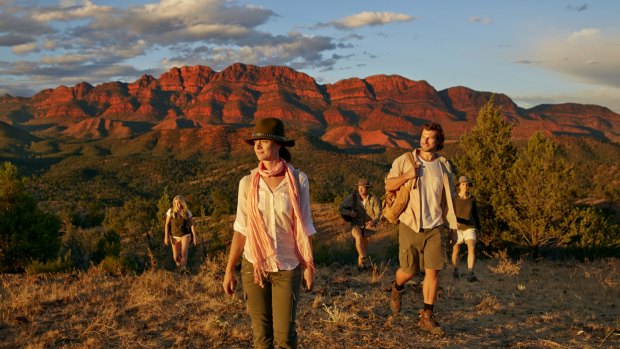
On the trail in the Flinders Ranges.
"Who's up for an adventure?" asks our guide, Kat Mee, with a glint in her eye. Eight of us sign up, falling in behind her as we begin a slow ascent of the Red Range, a jagged spine of sandstone in South Australia's Flinders Ranges. The conversation trails off as the terrain gets steeper and more technical, the pine-studded ridgeline narrowing until it's just a metre wide.
Either side are vertiginous drops, compelling reminders to focus on our feet rather than the majestic views. Near the top, we have to clamber around an impassable rocky outcrop, edging carefully down a slippery, scree-covered slope before a final scramble to the summit. "That was nuts!" says Chris, a trim 62-year-old fellow walker, beaming with boyish glee.
South Australia is now home to two of the 12 Great Walks of Australia, more than any other state except Tasmania with a disproportionate though impressive five.
For the first time, the two South Australian walks have been combined this year to create an epic nine-day "Ranges to River" trip. Guests spend four days hiking through the Flinders Ranges on the Arkaba Walk, then transfer to Renmark for a four-day exploration of Australia's longest river with Murray River Trails. For me and the rest of our party, it's an irresistible chance to experience two contrasting outback landscapes.
The Flinders Ranges is an eruption of dramatic peaks and soaring escarpments (most notably the vast, crater-like Wilpena Pound) that dates back more than half a billion years. By comparison, the Murray River is a toddler. A mere 600,000 years old, it snakes lazily through a parched floodplain dotted with red gums and black box.
Both face similar challenges. Large swathes of the Flinders have been overgrazed by cattle and sheep, while the Murray's annual flood cycle has been regulated using locks and weirs. Important native species in both have been decimated (dingoes in the Flinders, cod in the Murray) and introduced pests such as rabbits and carp have led to catastrophic imbalances.
While both walks provide confronting evidence of our species' misguided meddling, they're also helping to put it right. The 25,000-hectare Arkaba property removed the last of its sheep in 2013 and is now an active wildlife conservancy. Murray River Trails funds projects to improve the health of the river floodplain and the wildlife it supports.
It's a tricky balance – offering unashamedly upscale access to ecosystems you're trying to preserve. Not only do they both succeed, but they achieve it in intriguingly different ways.
FROM NATIVE CREATURES TO CREATURE COMFORTS
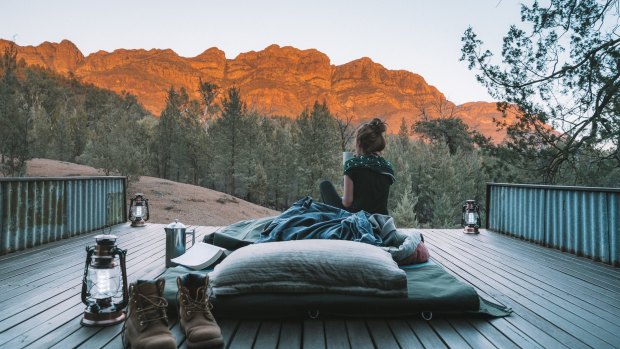
"Emus!" cries someone from the back of the bus. We've barely started the 35-minute drive from Arkaba's luxury homestead to the start of the first day's walk and already we've spotted a wedge-tailed eagle, a pair of common wallaroos and a flock of six emus.
Located five hours north of Adelaide, the Flinders Ranges is a harsh, unforgiving environment. We're here in June when the daytime temperature hovers in the mid-teens, but in summer it can soar to more than 40 degrees. Despite the challenging conditions, life still thrives.
Over the next few days, we'll encounter dozens of kangaroos and wallaroos, countless parrots, honeyeaters and fantails, plus encouraging evidence of the return of echidnas and dingoes.
We begin by following a section of the Heysen Trail (a 1200-kilometre trek named after noted landscape painter Sir Hans Heysen) through Wilpena Pound, a spectacular crown-shaped natural amphitheatre. It has special significance for the local Adnyamathanha people, who believe its walls were formed by two giant serpents.
As we climb out of the Pound through Bridal Gap, we see evidence of the region's tumultuous geological history in these towering ramparts – layers of limestone, sandstone and quartzite that formed during the Ediacaran period, a head-scratching, ancient 620 million years ago.
Descending on a goat track that zigzags through stands of white cypress, we approach our home for the night – Black's Gap camp, where host Marcela is waiting with hot towels and thirst-quenching glasses of chilled cranberry juice.
It's the first of two purpose-built bush camps we'll stay in, both equipped with five sleeping huts, two long-drop toilets and two ingenious bush showers fed by buckets of water warmed by the stove. The showers are open on one side, so you can lather up while enjoying mesmerising views of the surrounding ranges. Just don't linger too long like I did one day and run out of water mid-shampoo.
After a steaming cup of minestrone soup by the fire, we gather for dinner at a table under the stars. It's a gourmet affair, prepped by the chefs at the homestead then finished by the guides. Tonight's feast features tender lamb shanks with turmeric salt potatoes followed by a flourless chocolate cake with raspberry coulis. Needless to say, plenty of excellent South Australian wine is also enjoyed.
Back at the open-sided sleeping hut, I strip down to my thermals. The temperature has dropped to single figures, but thanks to a hot-water bottle, my swag is toasty and snug. In the morning, I'll be woken by the distinctive call of a butcherbird, watch the sun creep down the burnt-orange hillsides and eventually be lured out of bed by enticing aromas of fresh coffee and bacon.
OF RED RANGES AND RIVER RED GUMS
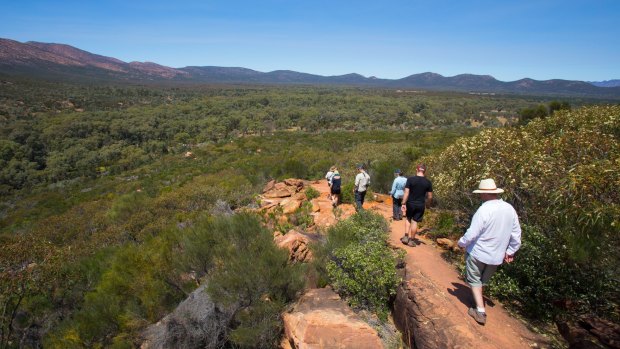
Credit: Graham Michael Freeman
After climbing to the summit of the Red Range on day three, we push our way through a dense tract of acacia bushes until we're back in one of the meandering drainage creeks that criss-cross the property. It's this topographical variety that really defines the walk.
One minute you're enjoying morning tea on a rocky outcrop surrounded by mountainous, horizon-straining views, the next you're following a narrow drainage channel flanked by towering river red gums.
Whatever the terrain, Kat's ability to spot flora and fauna verges on the supernatural. She frequently points out wallaroos perfectly camouflaged against distant hillsides, finds tiny trapdoor spider burrows hidden in the dirt and notices bashful outback blooms, such as the dainty white-and-purple Early Nancy.
After three days of hiking 12-16 kilometres a day with some challenging climbs (most of which are optional), the Arkaba homestead is a welcome sight. A member of the Luxury Lodges of Australia grouping, the five-bedroom property is an intimate, character-filled retreat with comfortable king-size beds, exposed stone walls and decadent clawfoot baths.
Our last dinner starts with fireside gin and tonics before a lavish feed of beef cheeks on velvet mash and panna cotta with poached pear. It's an appropriately indulgent finale before tomorrow's five-hour drive to Renmark for the second half of this Great Walk double-header.
As we file back to our rooms, one of the group remarks dryly, "It'll be nice not to have to ask someone to fill our shower in the morning."
A HOUSEBOAT NAMED DESIRE
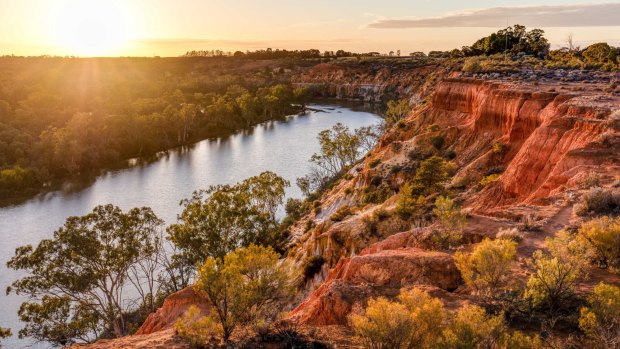
I can safely say that of all the things I expected to see in the bushland flanking the Murray River, the faded outline of a cricket pitch wasn't one of them. The pitch is part of the remnants of an internment camp that housed Japanese pearl divers during World War II. "Bugger nature," says Martin, a 75-year-old former cricket umpire, "this is the highlight of the day."
We stop for lunch nearby, guides Drew McDonald and Kym Manning producing camping chairs from an old hut so we can enjoy a packed lunch of quinoa salad with salami and feta overlooking a tranquil bend in the Murray. Of course, the nature has been pretty damned impressive.
During the 90-minute boat trip from Renmark to the start of today's walk, we see squadrons of barrel-chested pelicans gliding like B-52 bombers, V-shaped flocks of flying cormorants and whistling kites soaring above the treetops. While hiking beside an inlet choked with bulrush, we watch western grey kangaroos bound across a distant floodplain and crane our necks to marvel at a large sea eagle nest cradled high in a red gum.
After lunch, we cross a dusty, arid field and walk along Squiggly Creek, its sun-baked bottom a maze of cracked mud. Drew explains that there are dormant phytoplankton in the cracks "just waiting for a drink".
Since the Murray's flow has been controlled with locks and weirs, the floods that would have filled this creek don't happen as often. "They're few and far between now," says Kym. "When I was a kid, they'd be every two to three years, now it's every 10 to 15."
It's our first insight into the complex and highly politicised water management issues that continue to plague the Murray. Later in the trip, Drew will provide an informative overview, but for now, as we walk through a haunting, desolate landscape of decaying gum trees, it's clear we're still not getting it right.
After hiking up to a viewpoint overlooking Headings Cliffs, we get our first proper look at the Murray's famous rock walls and their clearly defined layers of limestone, Blanchetown clay and two-million-year-old sand. Resting demurely against the opposite bank is our home for the next three nights – a houseboat named Desire. Soon I'm admiring this impressive cliffside panorama from its outdoor spa with a chilled glass of sparkling wine.
Unlike the Arkaba Walk, where our luggage was ferried between each camp, here the camp moves with us. It's a sumptuous base to return to each afternoon, with five double cabins, two shared bathrooms and a spacious communal lounge and dining room.
THE MIGHT OF OL' MAN MURRAY
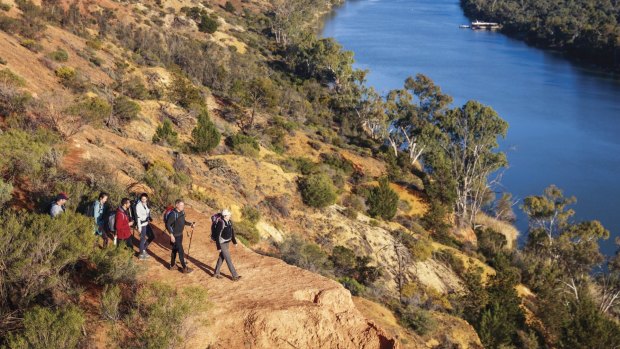
Credit: Jonathan van der Knaap
Over the course of the trip, we're served a succession of restaurant-quality meals, such as golden perch chowder followed by river mint linguine, all prepped onboard by our versatile guides and paired with an imaginative selection of South Australian wines.
During the next two days, Drew and Kym guide us along meandering inlets, across savannah-like floodplains and through dense pockets of bush. They point out trees with canoe-shaped scars, explaining how Indigenous people removed the bark using shards of sharpened chert.
We listen to water gurgling inside ancient red gums, taste the sweet red berries of ruby saltbush and run our fingers over the gnarled trunks of twisted black box.
On the final day, we're encouraged to walk the last two kilometres on our own. It's a bright, breathless morning and above the tranquil Murray pelicans glide back and forth on its mirrored surface while darters dry their out-stretched wings on the shore. Echoing among the red gums are the distinctive cries of corellas, kookaburras and white-winged choughs.
Ten days ago, I'd have struggled to identify a single flower, bird call or animal track in either of these magnificent Australian landscapes. Now, thanks to this clever and considered pairing of walks, led by two sets of infectiously passionate and wonderfully knowledgeable guides, they feel like reassuringly familiar treasures.
Rob McFarland was a guest of Wild Bush Luxury, Murray River Trails, Great Walks of Australia and the South Australian Tourism Commission.
THE DETAILS
WALK
The nine-day Ranges to River self-drive package costs $4216 a person, and includes two nights bush camping, two nights at the Arkaba homestead, three nights on a houseboat and one free night in Renmark. Upgrade to the fully-hosted option ($4820 a person) for transfers to/from Adelaide and a night at the Renmark Hotel. There's about 82 kilometres of walking (Arkaba 42 kilometres, Murray River 40 kilometres) plus optional climbs. Daypacks to carry a rain jacket, extra layers, water and a packed lunch are provided. Luggage is transported ahead to each camp or travels on the houseboat.
Both options include all meals, snacks and selected South Australian wines. Maximum group size is 10. The next departures are August 25 and September 1, with 2022 dates to be announced soon. Single route walks operate in autumn, winter and early spring (Arkaba from mid-March to mid-October and Murray River from May to September).
INVEST IN A PAIR OF BINOCULARS
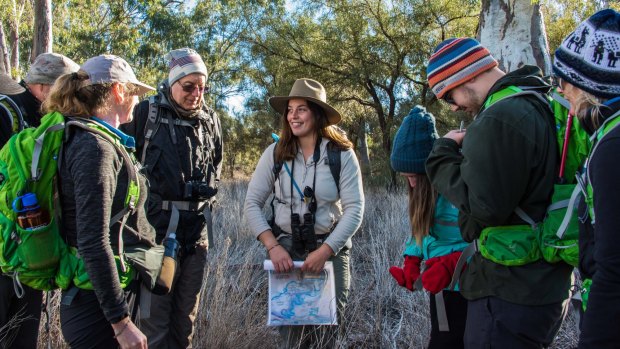
Guests and guide on the Murray River Walk. Credit: Neil Hendry
Rather than waiting in line for the guide's binoculars and missing that once-in-a-trip wildlife sighting, bring your own and have them easily accessible.
DON'T SUFFER IN SILENCE
Even well-worn hiking boots can cause niggles on a multi-day walk. Alert your guides to the smallest hot-spot so they can treat it before it becomes a trip-ruining blister.
Lightweight layers are your best friend. Days start chilly but soon warm up so you'll want plenty of fast-wicking synthetic layers and a rainproof outer jacket.
TURN OFF AND TUNE IN
Don't squander that epic hilltop view trying to access emails with one bar of coverage. Turn on your out-of-office, switch your phone to aeroplane mode and savour the moment.
PACK SOME SPARE BATTERIES
There are no charging facilities at Arkaba's two bush camps so bring a couple of fully-charged power banks so you don't run out of juice.
FIVE MORE THINGS TO DO AND SEE IN SOUTH AUSTRALIA
WINE AND DINE IN STYLE
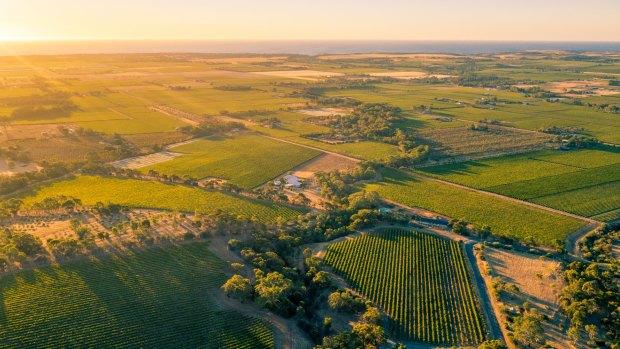
Vines to sea in McLaren Vale, South Australia.
South Australia is almost unfairly blessed with world-class wine regions with a dozen of them in total. Enjoy a cool-climate sav blanc in the Adelaide Hills, a Mediterranean-style fiano in McLaren Vale or a big, bold shiraz in the Barossa.
HOP OVER TO KANGAROO ISLAND
The island has staged a remarkable recovery since the devastating bushfires of January 2020. Explore the rejuvenated landscape and look out for its unique sub-species of kangaroo, echidna and dunnart.
GO COASTAL FOR AN AQUATIC ADVENTURE
Having pioneered cage-diving with sharks, the Eyre Peninsula now offers swimming with sea lions, dolphins and even giant cuttlefish.
ENJOY THE BRIGHT LIGHTS OF A COMPACT CAPITAL
Thanks to a flurry of interesting new hotels (check out EOS skycityadelaide.com.au and Hotel Indigo Adelaide Markets ihg.com/hotelindigo, innovative eateries like Africola and Madre, plus a lively laneway bar scene centred around Peel Street, Adelaide is an even more compelling destination in its own right.
GO DEEP IN THE LIMESTONE COAST
Explore the Limestone Coast's geological oddities, such as the verdant Umpherston Sinkhole in Mount Gambier, the striking, cobalt-coloured Blue Lake and the subterranean wonderland of Naracoorte Caves.
Sign up for the Traveller Deals newsletter
Get exclusive travel deals delivered straight to your inbox. Sign up now.